|
| Book Transcription |
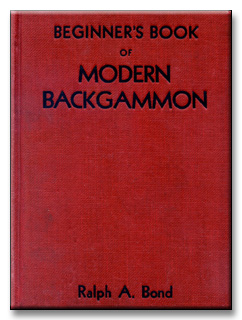
|

|


AHSTON STEVENS
who spontaneously said about the popularity of the game,
“I TOLD YOU SO”
In publishing this book, I am indebted to Mr. Harry Sidney Stevens and Miss Alice Stevens who have collaborated with me in writing what I believe to be a simple treatise on how to learn to play Modern Backgammon. — RALPH A. BOND
In preparing this revised and enlarged edition of my book I wish to gratefully acknowledge the interest and cooperation of Adelaide Mary Walsh and Dorothy Ethel Walsh, who made the preparation agreeable and possible. — RALPH A. BOND

The History of the Game
Since the time of the ancient Egyptians, the spirited play peculiar to the game of Backgammon has commanded an ardent and devoted following. It has been played for centuries in England and for years in America by a small, but enthusiastic group, which for want of a better term might be called fashionable society. Until recent developments gave life to the modern style of play, the game remained unchanged through the ages.
Now new zest has been added to the pleasure of playing Backgammon, making it thoroughly modern. It has. suddenly become a most widely accepted form of entertainment irrespective of social settings, and regardless of seasons.
The three changes in the ancient game which have been responsible for its present-day rebirth and tremendous popularity are, (1) “doubling” which greatly increases its possibilities as a game of chance, (2) “Chouette” which removes its former limitation as a two-handed game and permits backgammon to be played by as many as six or more people, (3) the use of the doubling cube which makes clear at a glance the stakes and the player’s standing in the game. It replaces the antiquated use of matches which has been aptly described as a “cord of wood” in a game where there is considerable doubling and redoubling.
These changes or modifications are fully explained in their proper place further along in this book.

Object Of The Game
Briefly, the game is a race of the draughtsmen, the object of each player being to move his men into his inner table and when all are there, remove them from the board. The player who first removes all his men from the board wins the game. The moving and bearing off (removing) are done according to the throws of the dice.

List Of Terms Used In Modern Backgammon
BACKGAMMON: Is a triple game which in scoring counts three.
BAR: That part of the board which separates the inner and outer tables. All “blots,” which are “hit” or “taken up” are placed upon the bar and rest there until re-entered.
BAR POINTS: Points next to the bar in the two outer tables.
BEARING OFF: Process of removing the men off the board by throws of the dice.
BLOCK: When a player has “made” a point in his inner table, that point is “blocked” against the reentry of his adversary’s men on the bar.
BLOCKING: Usually three, four or more consecutive points occupied by one player’s men which prevents the adversary from making a move.
BLOT: A single man upon any point.
BORDER: That part of the board which surrounds the field or player’s tables.
BUILDERS: More than two men on a point are called builders, and are used to make additional points for the player.
CHECKERS: The men or draughtsmen used in the game are sometimes incorrectly called checkers.
CHOUETTE: The method by which more than two can play Backgammon in the same game.
DICE: The small cubes used in making the throws for the moves of the men.
DIE: Singular of dice.
DOUBLE (Automatic): If when throwing for the first move the player’s and adversary’s dice are tied, the stakes for which the game is played are automatically doubled. This may occur any number of times.
DOUBLE (Declared): Before a player has thrown his dice, the player may declare the stakes of. the game doubled. The privilege of declaring a double thus passes to his adversary.
DOUBLETS: When the pips on the two dice thrown are identical the player is entitled to double moves.
DOUBLING CUBE: The cube which is used in Modern Backgammon and the method by which the game wager is kept in front of the players at all times.
DRAUGHTSMEN: The men or as sometimes incorrectly called checkers used in playing the game.
ENTER (To): Re-entering a man which has been placed upon the bar.
FIELD: That part of the board upon which the game is played, comprising Black’s inner and outer table and White’s inner and outer table.
GAMMON: A double game which in scoring counts two.
HIT (Taken Up): When a player throws a number that allows him to place a man on a point occupied by an adversary’s “blot” (single man), the “blot” is “hit” or “taken up.”
LINE or MARCH: The routes the men follow by moving in opposite directions in their race for each player’s inner table.
MAKING A POINT: When a player is able to place two or more men on a point.
MEN: The draughtsmen used in the game.
PIPS: The markings on the dice.
POINTS: The twenty-four points alternately colored on the board on which the men are moved according to the throws of the dice.
SET-UP: The men placed in proper position on the board at the start of the game.
SHUT OUT: If the player’s inner table is completely closed to the entering of the adversary’s men from the bar, it is called a “shut out.”
SIDE PRIME: Six consecutive points occupied by a player’s men constitutes a Side Prime.
SINGLE GAME: A single game which in scoring counts one.
TABLES: The board is divided into four tables, the player’s inner and outer tables and the adversary’s inner and outer tables.
TAKEN UP (Hit): Where a lone man (blot) upon a point is sent back to the bar by the adversary he is “taken up” or “hit.”

Equipment And Set-Up
Backgammon is played upon a special board with draughtsmen and dice.
Four “tables” make up the board, each “table” having six “points” which are colored alternately in two colors. The two “tables” nearest to the White player are called White’s inner and outer “tables” and the two “tables” nearest to the Black player are called Black’s inner and outer “tables”. A raised bar separates the inner and outer “tables” and surrounding the whole board there is a raised border.
No numbers differentiating the points appear on the Modern Backgammon board itself, but all players learn to identify each point by a number with the exception of the bar points (the points next to the bar in the outer tables). In the count these latter would be 6, but they are never called by number, being known only as bar points.
The correct point numbering is from 1 to 6 in each inner table, starting the count from the outer edge of each table to the bar. Thus the point nearest the outside border is 1, the next is 2 and so on up to the point next to the bar which is 6.

In the same manner the count in the outer table starts with point 1 nearest the outside border and, working toward the bar, the following points are 2, 3, 4, 5 and the bar point.
The correct and scientific system of numbering of the points on the board, as is shown in Diagram 1.
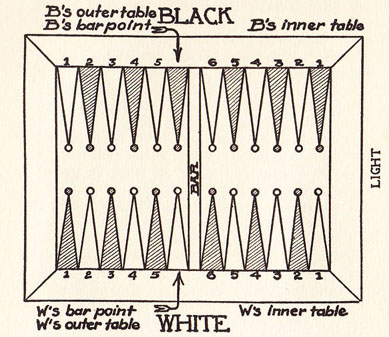
| Diagram 1 — The board |
| The numbers do not appear on the actual playing boards themselves, therefore they should be memorized. |
In the correct play of Modern Backgammon the points should never be numbered from 1 to 12 across the board, nor should the points in the outer tables be numbered with the bar point starting as number 1.
There are fifteen white men for one player and fifteen black men for the other, and there are arranged upon the field (the field is the place of action) as is shown in Diagram 1.
The men are arranged so that the home or inner “tables” are nearest the light. In olden days the game was often played in vast and poorly lighted interiors. Because the window lighting was inadequate and the only artificial light obtainable was through the use of tapers or the flare of a sputtering lamp, the rules for setting up the board were built around the idea that the inner tables — where much of the important playing is done — should be placed in the best light. Our modern lighting facilities for flooding the entire room makes this a less important point, but because Backgammon is a game of many traditions a number of its traditions cling to the modern version. The set-up as described is one of them.
In the original set-up at the start of the game the black and white men are so placed as to be directly opposite each other and there are always the same number of “Black’s” men and “White’s” men on corresponding points. See Diagram 2.
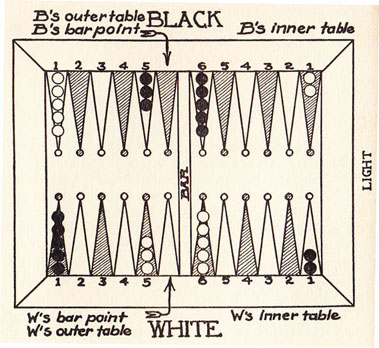
| Diagram 2 — The set-up |
| At the start of the game the men are arranged on the board as shown in the above diagram. You will notice that both Black and White have the same number of men on points opposite each other. |
After a moment’s study of the starting position of the men and of the position of the LIGHT, which in every instance here, is to the right of the illustration, it is apparent that the two men on either ace point of the inner,“tables” and the five men on either ace point of the outer “tables” and the three men on either five point of the outer “tables” have to pass each other before their objective is gained. The five men on either six point in the inner “tables” and the three men on either five point of the outer “tables” serve as “builders” in making points in one’s inner “table.”
Two dice-boxes are required, one for each player. It is correct to have one pair of dice, which are used by both players, but generally for convenience each player is provided with a pair of dice.
Die is singular — dice is plural. When the word die is used on the following pages it refers to one of the pair of dice. The word dice indicates the pair of dice used by each player.

Playing The Game
To determine the right to play first, each player throws one die and the one whose die shows the greater number of pips adopts both the numbers thrown (his own and his adversary’s) as his throw and makes his opening play accordingly. Thereafter each player in turn throws two dice.
Doublets count double and when they are thrown, four instead of two moves of the numbers thrown are made. These may be made separately with different men or all with one man.
The men are moved from point to point according to the numbers thrown. White moves from Black’s inner table to Black’s outer table, then across to White’s outer table and from there to Whites inner table. When all of White’s men are in his inner table, he moves them off the board. Black moves in the same manner but in the opposite direction. This is called The Line of March (See Diagram 3).
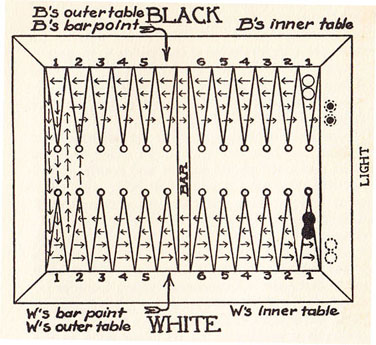
| Diagram 3 — Line of march |
| The arrows in the above diagram show the direction which each player’s men follow in their race toward their own inner table. Black’s men move clockwise while White’s men move counter-clockwise. |
The player moves his men the number of points that correspond with the number of pips that turn up by his throw of the dice, provided that the point to which the player moves his man is not “blocked” by having two or more of the adversary’s men on it. He can move one man the total number of pips on both dice or he can move two men, each one the number of pips on one die.
It is permissible to pass over a blocked point in order to reach a free point, but if the pips on both dice are being used to move one man, these pips must be played separately and the man being moved must rest upon a free point before playing the pips on the second die.
In moving the men, dice of odd numbers take them to points that are the opposite in color to the point from which they are played. Dice of even numbers take the men to points of corresponding color. The move is counted from the point next to the one occupied by the man to be moved.
Blocking
As explained previously a “blocked point” is one upon which there are two or more of the adversary’s men, and, while there is no limit to the number of his own men which a player can put upon a point, he cannot play upon a blocked point established by his opponent.
If a player is “blocked” so that he cannot play either or both the pips on the dice he loses that throw. The player is compelled to move the entire throw if possible and should he be able to play either one, but not both, of the dice thrown, he must play the larger.
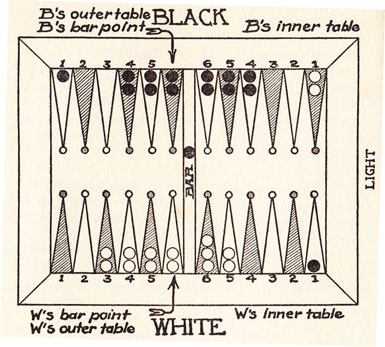
| Diagram 4 — Blocking |
| In the above diagram White has established six blocked points on his tables and by doing so has trapped Black’s man in White’s inner table and limited Black’s re-entry of his man from the bar to points 1 to 4 of White’s inner table. |
In Diagram 4 Black has thrown double fives with one man upon the bar. The 5 point in White’s inner table is blocked by two of White’s men. Black’s play, therefore, is blocked and he cannot re-enter until the pips on the dice thrown by him correspond to an open point in White’s inner table.
Blots
A single man upon a point is called a “blot.” This is shown in Diagram 5 where, after the game has commenced White leaves a single man unprotected upon the five point in his inner table.
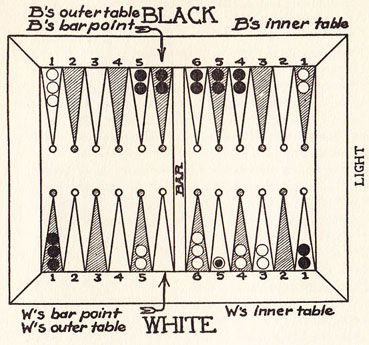
| Diagram 5 — A blot |
| In the above diagram White has left a lone man (blot) in his own inner table on point five. This can be taken up (hit) by Black and placed on the bar should a throw of the dice bring one of his men to this point. |
Hit Or Taken Up And Re-Entry
When a player throws a number which enables him to place a man upon a point occupied by a single man, or “blot,” of the adversary’s, this “blot” is said to be “hit” or “taken up.” The man having been “hit” is “taken up” and placed upon the bar which separates the inner and outer tables. The adversary must then begin again by entering this man in the player’s inner or home table, which he may do upon his next throw, provided the pips on the dice result in a number that corresponds to the number of an unblocked point. He can, however, enter his man on any point occupied by his own men.
If in re-entering a man taken up, the dice result in a number that will enable the player to take up a “blot” in the adversary’s inner table the throw serves two purposes. First it takes up a “blot” belonging to the adversary and, second, it re-enters the player’s man which has been taken up. If the player can both “hit” and enter with a single die he may move any of his other men (or the man just entered) the number of points corresponding to the pips of the second die.
As the game is a race of the draughtsmen, it is generally advantageous to take up “blots.” A man taken up must re-enter and start anew and this retards the adversary. Furthermore, a player may not move any other man when he has one or more men upon the bar to enter.
Making A Point
When a player moves so as to place two or more of his men upon the same point he is said to “make a point” as illustrated in the following diagram, where the player using the white men has thrown a three and a one. White now moves one man from No. 5 of his outer table and one man from Point No. 6 of his inner table to Point No. 5 in his inner table thus “making a point” as show in Diagram 6.
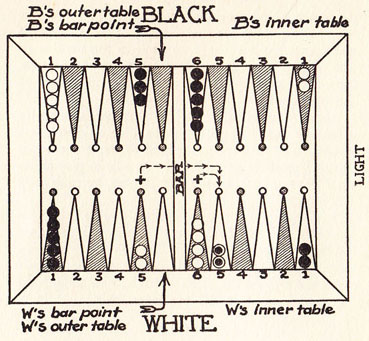
| Diagram 6 — Making a point |
| White has “made” his five point in his inner table by moving one man from the five point in his outer table and one man from the six point in his inner table. This blocks the point against his adversary’s men. |
It is to the player’s advantage to make all the points in his inner table, so that in the event that one of the adversary’s men has been taken up, it cannot be entered. This allows one to continue throwing and thereby advance his men while the adversary is unable to move any of his men until the man upon the bar is entered.
Builders
More than two men on a single point in the player’s inner or outer tables serve as “builders” to close the inner table against the entering or escape of the adversary’s men. A “blot” such as shown on the five point in the player’s outer table also serves the same purpose.
Diagram 7 illustrates a strong fort of “builders” for both White and Black to help close their inner tables completely.
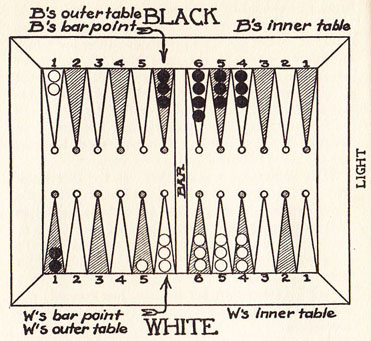
| Diagram 7 — Builders |
| The above diagram shows a strong fort of builders for both White and Black. Builders are used to help close the inner table against the entering or escape of the adversary’s man. |
The game is one of alertness, strategy and familiarity with the board and position of not only the player’s men but also the adversary’s. Very often the method of attack or defense can be determined from a glance at the position of the men.
The Bar Point
The bar point is the point next to the bar in the player’s outer table. It is considered desirable to block this point as quickly as possible because it makes it difficult for the opponent to get his two men out of the player’s inner table.
Bearing Off
The game continues until one player or the other succeeds in moving all his men into his inner table. The player then removes his men from the board by bearing from the various points corresponding to the pips on the dice thrown by him; i.e., if a player throws a three and a five he can “bear oil” (remove) a man from point three and another from point five. Should a certain number be thrown and the corresponding point unoccupied it is compulsory for the player to make a move, if possible. If desired, a move may always be made instead of “bearing off” a man.
If a player throws a higher number than any point on which he has a man, he can “bear off” a man from the next highest point he occupies. Thus if a six is thrown and the six point is unoccupied, a man may be borne from the five point, or the next highest point which is occupied. If a player throws a point upon which he has no man he cannot “bear off” from a lower point if at that time he has a man on a higher point; i.e., if a player throws a five and this point is vacant he cannot “bear off” from point four if he has a man on point six, but must move the man on point six to point one.
Should a player expose a “blot” after he has commenced the process of “bearing off,” and it is “hit” by one of the adversary’s men, the man so “hit” must be re-entered in the adversary’s home table and moved around the field and into the player’s inner table again before the player can continue “bearing off.”
If a player’s throw of the dice result in numbers of unoccupied points which are lower in number than any occupied point or points he must make the corresponding moves. If the adversary’s men were out of the player’s inner table and there was no danger of “blots” being taken up the player should move his men toward his ace point in order to “bear oil” his various men with every throw of the dice as the game goes on. If the throw results in the correct number, a combination of the two dice can be used to “bear off” a single man. Thus a man from the five point can be borne off the board with a 2-5 or 4-1 throw.
Doublets entitle the player to move or “bear off” four men, provided the pips on the dice are large enough in number to carry the men off the board. If the pips are not large enough in number to carry the men oil the board they must be moved the corresponding number of points.
It is considered advisable to “bear oil” a man rather than to move up a man except where doing so would leave a “blot” which his adversary might take up on the next throw. This would force the player to re-enter his man on the adversary’s inner table and again make the circuit of the board.
The player who is first in “bearing off” all his men wins the game.
If, before a player has succeeded in “bearing off” all his men his adversary has been able to remove one or more men from the board it is called a single game. It is a double game, or a gammon, and counts double, if the adversary has not been able to remove a single man. It is a triple game, or a backgammon if the adversary has not been able to take off a single man and is left with one or more of his men in the winner’s inner table or upon the bar.

Doubling
After the game is once under way either player may, before any of his throws of the dice, double the stakes of the game. The adversary has the privilege of declining this double, surrendering the stakes and commencing a new game, or accepting the double and continuing.
With the accepting of the initial double the adversary has the right to double the stakes of the game again and may declare this done before any of his throws. The initial doubler may accept and go on with the game or forfeit the stakes which have already been doubled once.
If this redouble is accepted the initial doubler then has the right to make a third double and he may declare this done before any of his throws.
When continued there may be a fourth double, a fifth double, and so on. There is no limit to the number of doubles which may be made in any one game, though very rarely are the stakes doubled more than five or six times.
The privilege of doubling is at first with either player; it then alternates, the player who accepted the last double having the right to double the stakes once more.
A player after doubling cannot double again until his adversary has made a double. This makes it possible for either player to limit the stakes after having accepted a double.
The wisdom in offering or accepting a double must, to a very great extent, rest upon the judgment and skill of the player. Generally speaking, it is unwise to declare a double very early in the game unless the player has made several advantageous throws in succession. The same is true about accepting the double. Bluffing by offering a double is like bluffing in poker, a dangerous procedure and while it adds to the thrill and gambling possibilities of the game, should be avoided at least by the inexperienced player.
Automatic Double
In throwing for first play at the beginning of a game, the stakes are automatically doubled if the players’ dice correspond to each other (tie). It is possible for the game to be doubled, three, four, or more times by the tieing of the dice before even the first move is made by either player. Either player may then, before any of his throws of the dice, double the game, regardless of the number of times the stakes have been doubled automatically by reason of the dice being tied when throwing for the privilege of making the opening play.
Because doubling gives to Modern Backgammon unlimited possibilities and tense situations in the amount of the wagers it is therefore advisable that at the outset of a game the players decide upon the question, “shall the doubling method be used in playing for gammons and back-gammons.”
Doubling Cube
The modern method of doubling is very simple. A cube, such as shown in the illustration below, is used. The numbers thereon are 2, 4, 8, 16, 32 and 64 and a turning of the cube will place the desired number on top. The cube answers at all times the question of the correct stakes and it can be moved from one side of the table to the other and placed in front of the player having the privilege to the next double.
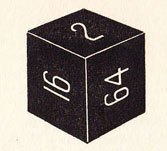
At the beginning of the game the 64 is usually placed face upward and with the first double it is changed to 2.

Scoring
The correct method of scoring in Modern Backgammon is by games.
Some innovations in scoring have been introduced from time to time such as counting the loser’s men left on the board, or totaling the games and men, but as counting by games has been the accepted method followed through the centuries the better players have deemed it inadvisable to change, and so have not given their support to any other but the original method.
As in all games of chance individual wagers may be placed upon throws; various combinations of the dice, etc., but it is advised that to avoid confusion you limit the wagers to the games in the usual recognized procedure of scoring.
It is this accepted procedure of scoring by games that is outlined in this book.
Scoring by games has its own diversity such as single game, gammon and backgammon.
As each is individual it is important that the players at the start of the game decide upon the question — Shall both gammons and backgammons be observed?
The three different games and the scoring are:
- The Single Game: It is a single game if one player has succeeded in bearing all his men from the board and the adversary has been able to remove one or more of his men also. The score is the original stake agreed upon. This may be doubled, redoubled and so on for as many doubles as are made and accepted during the game. It may also be increased by automatic doubles at the beginning of the game.
- A Gammon: This is winning a game before the adversary has removed a single man from the board. The score is doubled for a gammon. For example, if the original stake is one and during the game it has been doubled, which makes two, the player winning a gammon is entitled to four.
- Backgammon: This is winning a game before the adversary has taken off a single man and in addition is left with one or more of his men in the winner’s inner table or upon the bar. The score is multiplied by three for a backgammon. For example, if the stake of the game is one and it has been doubled once, the player winning a backgammon is entitled to six.

Opening Plays
Once the game is under way its development must depend almost entirely upon the judgment of the player, aided or hindered as the case may be by the very important element of luck. It is obvious that it would be impossible to name the best play upon a given throw of the dice after the game is fairly under way. The location of the men taken in connection with the numbers thrown, makes a variety of combinations far too numerous to analyze. The player must rely upon his own analysis of the situation and his best judgment of the most advantageous course to pursue.
Opening plays however for given throws have been quite generally agreed upon as the best and should be made when possible.
Of all throws, double aces is considered the best as this throw makes the five point in one’s inner table and the bar point in one’s outer table. The next best throw is double sixes as this makes both bar points.
The best opening plays of possible throws are described on the following pages with diagrams to illustrate them. For certain of these throws, alternate plays considered to be equally good or nearly so, are also given.
In making opening plays certain general principles should be borne in mind.
- If it is possible to cover a “point,” that is, place two men upon a point, it is generally considered good playing to do so.
- “Blots” should be left if possible only on strategic points, with the idea of being able to protect it on the next move, i.e., place another man upon it, thus making a point. Also, if possible, a “blot” should be left only where it is difficult for the opponent to take it up. It is more difficult to take up a “blot” with what is called a “single throw,” that is, where the total of the pips on the two dice is six or less, than it is to take it up with a “double throw,” that is, where the total of the pips on the two dice is more than six.
- It is always desirable to cover strategic point, i.e., the “bar point” in the player’s outer table and point 5 in the player’s inner table. The “bar point” because it blocks the adversary from getting a man out of the player’s inner table on a single throw and point 5 because it combines blocking, with closing one point in the player’s inner table to a re-entry by an adversary’s man who has been “hit.”
In the following pages devoted to “opening plays” WHITE is the “player” and BLACK is the “adversary.” The men moved are indicated on the diagrams by small black dots surrounded by a circle. The points from which they are played are marked by a cross. An arrow indicates the points to which they are moved.
Double Aces
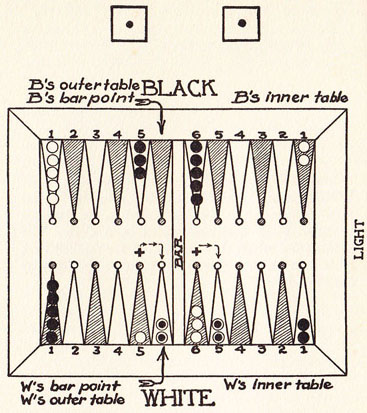
Diagram 8
White is player — Black is adversary.
Two men from point five player’s outer table to player’s bar point and two men from point six player’s inner table to point five.
Reason — The player has now succeeded in establishing three consecutive points and has a builder in his inner table and one in his outer table. With the five point established in his inner table the player has reduced the chances of escape for the adversary’s two men. The blot in the outer table is not in a dangerous position because it can be hit only by the combination of one and six, two and five and three and four.
Double Twos
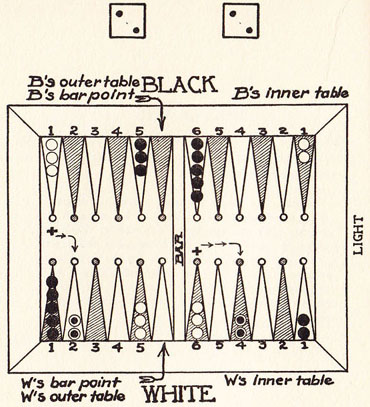
Diagram 9
White is player — Black is adversary.
Two men from point one adversary’s outer table to point two player’s outer table and two men from point six player’s inner table to point four.
Reason — In establishing the four point the player has hindered the moving of the adversary’s men from that table and closed the four point to any of the adversary’s men which might soon have been entered.
Alternate: Two men from point five player’s outer table to point four inner table.
Reason — Although men so moved made a four point, in his effort to do this, the player would overlook the only man in his outer table.
Double Threes
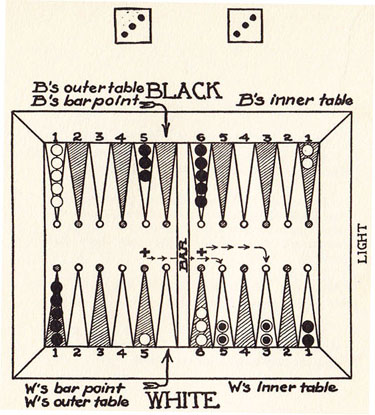
Diagram 10
White is player — Black is adversary.
Two men from point five player’s outer table to point five player’s inner table and two men from point six player’s inner table to point three.
Reason — If the blot is not hit, the player has several chances to protect it on his next throw or to make the four point in his inner table with a throw of four and two.
Alternate: Two men from point five player’s outer table to point five player’s inner table and two men from point one adversary s inner table to point four.
Reason — The blot in the player’s outer table can be hit only by six and one, two and five or three and four.
Double Fours
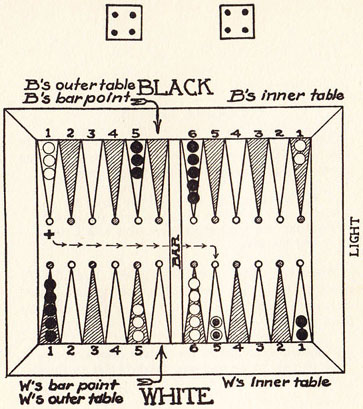
Diagram 11
White is player — Black is adversary.
Two men from point one a_dversary’s outer table to point five player’s inner table.
Reason — This move establishes the coveted five point without taking a single builder from the player’s men in his outer or inner tables.
Alternate: Two men from point one adversary’s inner table to point five same table and two men from point one adversary’s outer table to point four player’s outer table.
Reason — By this move the player establishes another point in his outer table.
Double Fives
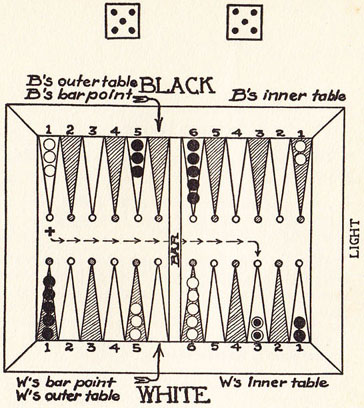
Diagram 12
White is player — Black is adversary.
Two men from point one adversary’s outer table to point three players inner table.
Reason — This is the only way one should consider playing double fives. The three point in the player’s inner table has been covered and the original builders in the p1ayer’s inner and outer tables are still available for making other points, the four and five points being preferred to the two point. To make the two point at this stage of the game would be to use valuable builders to make an unimportant point.
Double Sixes
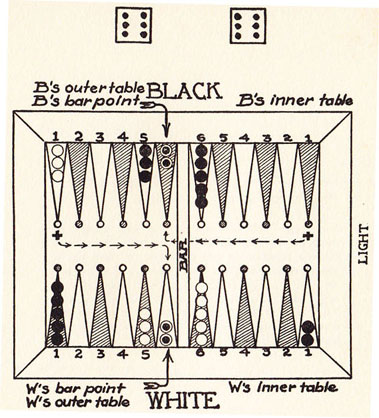
Diagram 13
White is player — Black is adversary.
Two men from point one adversary’s inner table to adversary’s bar point and two men from point one adversary’s outer table to player’s bar point.
Reason — With the player’s men occupying both bar points the adversary is at a disadvantage. Unless he gets doublets his men can be safely moved only into his inner table.
Alternate: Three men from point one, adversary’s outer table to the player’s bar point and one man from point one, adversary’s inner table, to the adversary’s bar point.
Reason — This covers the player’s bar point and in addition gives one more builder with which to make the points in his inner table.
Six And One
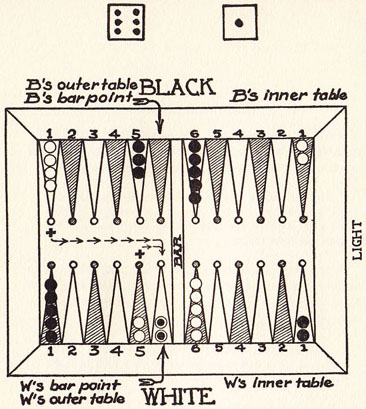
Diagram 14
White is player — Black is adversary.
One man from point one adversary’s outer table and one man from point five players outer table to player’s bar point.
Reason — This play establishes the bar point, giving the player three consecutive covered points, and may be the means of advancing one man the highest number of points (safely) on a single die. The bar point blocks only a six and is no longer important after the adversary has moved his men out of the player’s inner table. When he has done this the men upon this point can then be brought into more useful service as “builders” to help make the point in one’s inner table.
Six And Two
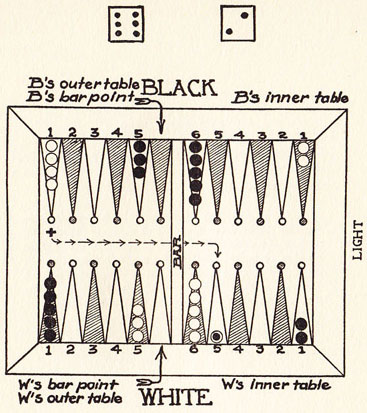
Diagram 15
White is player — Black is adversary.
One man from point one adversary’s outer table to point five player’s inner table.
Reason — This will make it necessary to leave a blot. But the player advances the man to his most valuable point which on the next throw, he has several chances of establishing.
Alternate: One man from point one adversary’s inner table to point four adversary’s outer table.
Reason — This move also exposes the man to a four and if on the next throw he is moved past the adversary’s five men on the player’s outer table he is still exposed to the adversary’s men in the player’s inner table.
Six And Three
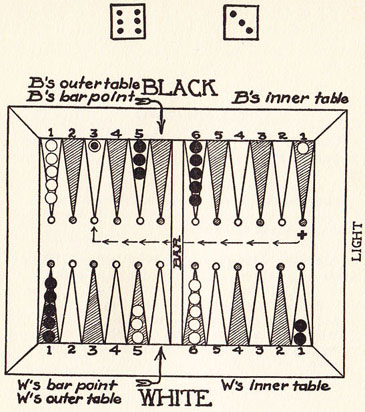
Diagram 16
White is player — Black is adversary.
One man from point one adversary’s inner table to point three adversary’s outer table.
Reason — This leaves the man exposed. But there is no way a six and three can be safely played at the outset of a game. If not hit on the adversary’s throw, the player may be hopeful that he can use this man to advantage in making a point in his outer table. This will help to hold back the adversary’s men starting from the player’s ace point.
Six And Four
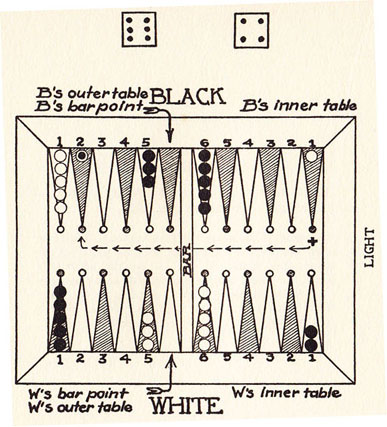
Diagram 17
White is player — Black is adversary.
One man from point one adversary’s inner table to point two adversary’s outer table.
Reason — This leaves the man exposed only to a two, provided the adversary did not win the opening play and place one of his men in the same position in the player’s outer table. If so the player would be taking considerable risks in exposing his man.
Alternate: One man from point five players outer table to point two player’s inner table and one man from point six player’s inner table to same point.
Reason — This play would make a point but it is not advisable so early in the game as men moved so far into the inner table are practically out of play.
Six And Five
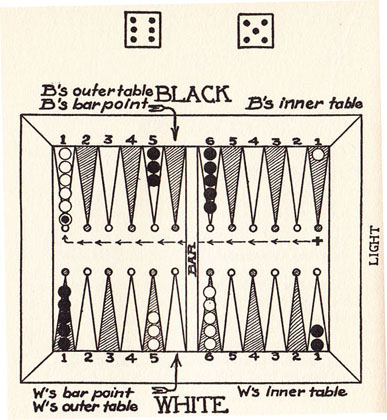
Diagram 18
White is player — Black is adversary.
One man from point one adversary’s inner table to point one adversary’s outer table.
Reason — This move is sometimes referred to as the “lover’s leap” and carries a single man half way around the board to an occupied point. The blot in the adversary’s inner table is in no immediate danger. Should the player have another blot taken up later in the game and be successful in entering it in the adversary’s inner table, it is possible to protect it with the blot from the ace point.
Five And One
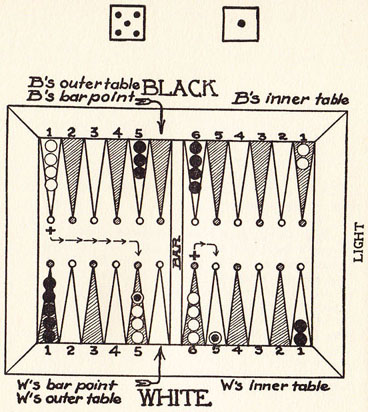
Diagram 19
White is player — Black is adversary.
One man from point one adversary’s outer table to the three men on point five player’s outer table and one man from Point six player’s inner table to point five.
Reason — This leaves a “blot” on the inner table but the five point is very important and the player then has several chances of covering it on the next throw if not “hit.” A combination of eight or three on the next throw of the dice or a single die of three or one or double fours will protect the blot if it is not taken up.
Five And Two
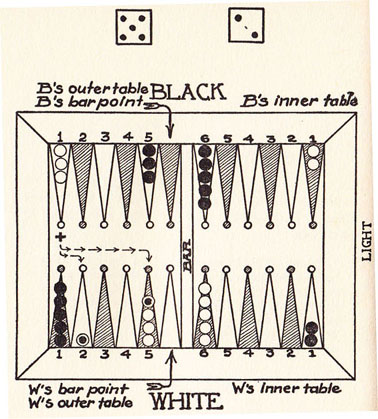
Diagram 20
White is player — Black is adversary.
One man from point one adversary’s outer table to point two player’s outer table and one man from same point to point five player’s outer table.
Reason — The man moved to the five point is safe. The man moved two points is comparatively safe for it can be hit only with a six and four. The advantage is that on the player’s next turn it may be brought into useful service as a builder in making the bar point or some other point in the player’s outer table.
Five And Three
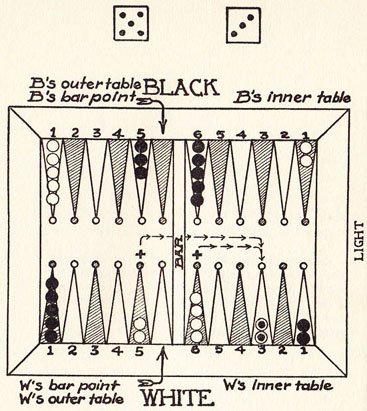
Diagram 21
White is player — Black is adversary.
One man from point five p1ayer’s outer table to point three player’s inner table and one man from point six to same point.
Reason — While this play establishes the three point and is almost universally played in this manner, some players consider it as moving the men too far into one’s inner table. Therefore they prefer the.
Alternate: One man from point one adversary’s outer table to point five player’s inner table.
Reason — This leaves a man exposed on the five point, but, however, with several chances of protecting it on the next throw.
Five And Four
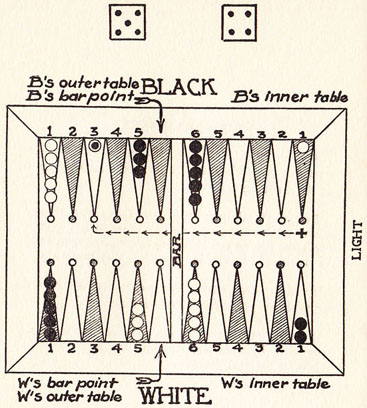
Diagram 22
White is player — Black is adversary.
One man from point one adversary’s inner table to point three adversary’s outer table.
Reason — This is a poor throw. To play one man as far as it will go (played the same as a six and three) seems to offer the greatest possibilities. If not hit upon the adversary’s next throw, the man may be used to make a point in the player’s outer table.
Alternate: Two men from the ace point adversary’s outer table, one man to point four and one man to point five, player’s outer table.
Reason — This is a conservative play. It gives the player, on his next throw, an opportunity to make his bar point or five point in his inner table.
Four And One
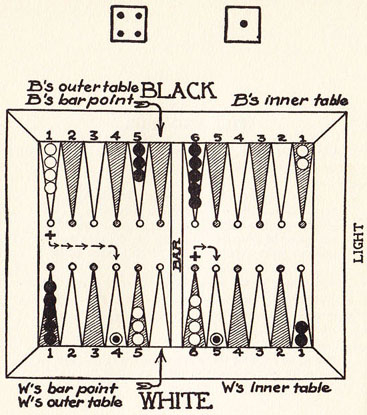
Diagram 23
White is player — Black is adversary.
One man from point one adversary’s outer table to point four player’s outer table and one man from point six p1ayer’s inner table to point five.
Reason — This may be taking risks but the possibilities of this play justify doing so. Both blots can be taken up by double fours for the adversary but the chances are against him being so fortunate. The player, on his next throw, then has more than the average number of chances of making his five point, or his bar point. If one of his blots is taken up he should have no difficulty in entering the adversary’s inner table.
Four And Two
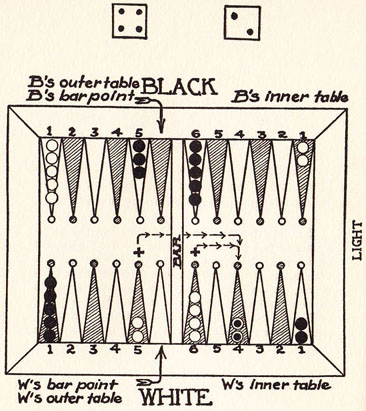
Diagram 24
White is player — Black is adversary.
One man from point five player’s outer table to point four player’s inner table and one man from point six player’s inner table to same point.
Reason — This is a desirable throw, and is always played in this manner. It not only makes a point for the player but also gives him three closed points which are a source of worry to the adversary. The chances of the adversary’s men being taken out of the player’s inner table are reduced.
Four And Three
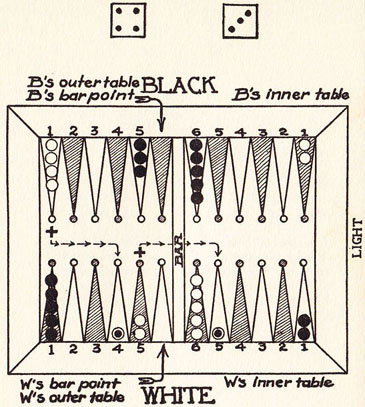
Diagram 25
White is player — Black is adversary.
One man from point one adversary’s outer table to point four players outer table and one man from point five player’s outer table to point five player’s inner table.
Reason — This play gives the adversary a chance to take up two blots with double fours. However should he hit either blot the player will have little trouble in re-entering as the game has just started.
Alternates: Two men from point one adversary’s outer table to points three and four player’s outer table.
Reason — This play is more conservative as it is possible for the adversary to hit only one of the player’s men.
Three And One
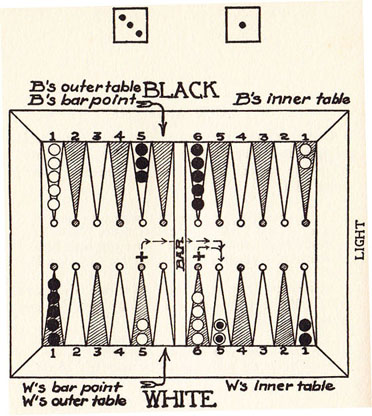
Diagram 26
White is player — Black is adversary.
One man from point five player’s outer table and one man from point six player’s inner cable to point five inner table.
Reason — Wherever backgammon is played a three and one are moved to cover the player’s five point. This move is universal and is known as a “book play.” This throw offers an excellent opportunity to establish the desired five point and should always be played in this manner. There is no other way in which a three and one can be played safely when it is an opening move.
Three And Two
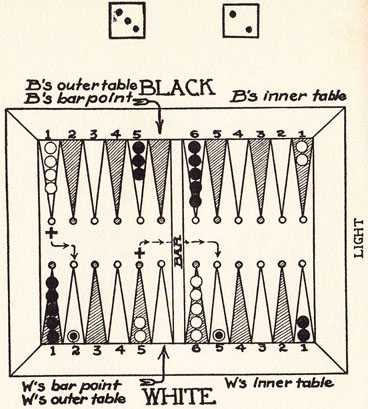
Diagram 27
White is player — Black is adversary.
One man from point one adversary’s outer table to point two player’s outer table and one man from point five player’s outer table to point five player’s inner table.
Reason — This gives the player an opportunity, on his next throw, to cover his five point with the blot left on the two point in his outer table.
Alternate: Two men from point one adversary’s outer table to points two and three players outer table.
Reason — In this position it is impossible for the adversary to take up more than a single blot.
Two And One
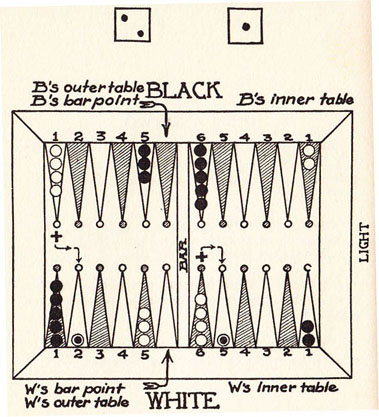
Diagram 28
White is player — Black is adversary.
One man from point one adversary’s outer table to point two player s outer table and one man from point six player’s inner table to point five.
Reason — This leaves two blots which can be hit by a combination of four and six but the chances are eleven to one against its being hit. The player is then able to make his five point with an eight, a six, a three or a one.
Instead of playing the one die from the six to the five point the player may move one man from the ace point in the adversary’s inner table. This might discourage the adversary in attempting to establish his five point by beginning to do so with a blot.

Varying Strategic Plays
The Running Game
Backgammon is a race of the men, the object being to carry all one’s men into the home table and thence off the board.
The Running Game consists merely in concentrating all your efforts on getting your men into your home (inner) table and off the board as quickly as possible.
Where one throws favorable dice, such as an initial throw of double sixes followed by several large throws, it is advisable to play a running game, as it is possible with a running game to bring the game to a close a short time after the first play is made. But this is not always possible and for safety’s sake it is better to make points here and there, preferably in one’s inner and outer tables as you proceed.
A perfect running game is often hindered by the hitting of “blots” and the progress of the game thus slowed up. Therefore avoid hitting your adversary’s “blots” if possible because they may be dangerous to you when re-entered.
The disadvantages to the running game are that frequently the adversary takes advantage of it, in that it offers little opportunity of slowing up the progress of the adversary’s men and that because it offers so little resistance and attains such speed itself, it hastens the adversary’s men on their way and thus establishes the possibility of the adversary outrunning the player.
Another disadvantage to the running game is that it holds down the stakes because, once having passed the adversary’s men and heading for home, winning a gammon (double game) is almost an impossibility as the adversary will have little trouble in removing one or more men from the board.
The Blocking Game
The blocking game is more effective than the running game and a combination of running and blocking is equally so.
In the blocking game we endeavor to block the escape of the adversary’s two men from our inner table. To do this we must cover our most valuable points which are considered to be the player’s bar point, the five point in his inner table.
If the adversary’s two men are still on the player’s ace point, the player’s bar point is more effective in keeping them there than the player’s five point. If one of the adversary’s men has escaped, the player’s five point is more effective as it not only blocks the adversary’s unmoved man but also gives the adversary one less point to re-enter a “blot” hit by the player.
The effectiveness of making the five point in the adversary’s inner table in the blocking game is clear as it prevents him from making the point and thus establishing a block to the player’s men. It also offers a good opportunity to the player of taking up any “blot” left by the adversary in his outer table.
Side Prime
A “side prime” is the closing or making of six or more consecutive points with two or more men on each point that trap or “pocket” one or more of the adversary’s men. This is the establishment of a perfect blockade. Since the highest possible throw of a single die is six, it is impossible for the adversary’s men to escape until the player is forced to open a point or leave a “blot.”
Diagram 29 illustrates a “side prime” with two of Black’s men on the ace point of White’s inner table. The two black men are helpless, cannot escape and it is necessary for Black to move one or two of his other men on his throw of the dice. A “side prime” is possible at other points on the board as illustrated in Diagram 4, where both White and Black have six consecutive points covered and have at least one of the adversary’s men blocked.
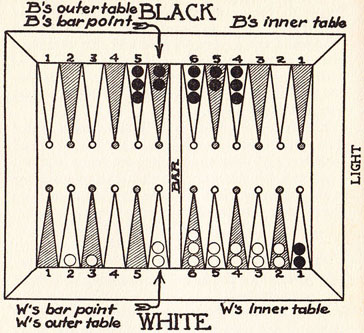
| Diagram 29 — Side prime |
| The above diagram shows a side prime established to trap the adversary’s two men on the ace point. As the highest possible throw of a single die is six, Black’s men cannot escape from White’s inner table until the side prime is broken up. |
The Back Game
The back game presents modern Backgammon’s most difficult test. It should not be attempted by the Beginner. It is the most scientific and consequently the most difficult of the various games to master. For that very reason it is the most intriguing and fascinating. Experience and practice will make possible the mastery of the back game. The back game is not advised unless the adversary has advanced through initial advantages and the opportunity to play a running game is lost.
It should be borne in mind that in winning a back game the results will be a single game (not counting, of course, automatic and declared doubles) while defeat means the loss of a double game.
The strategy of the back game is in establishing points in the adversary’s inner table. When the adversary begins to “bear off” his men he must leave a “blot.” Having taken up this “blot” the player starts this “rear guard” of his toward home, being watchful to keep several points apart at all times so that he will be able to hit continually the adversary’s re-entered man so soon as he comes within hitting distance.
These “rear guard” men also can be used effectively to establish the points in the player’s outer table which would be effective in blocking the progress of the adversary’s re-entered man.
As the back game progresses it will be found admirable for the player to expose “blots” in the adversary’s inner table, hoping that the adversary will play his small dice to hit these blots and give the player an opportunity of hitting his adversary’s “blots” as he re-enters his men. This means that the adversary must enter these men behind the blockade that has been established in the player’s outer table.
These adversary’s blocked men will not escape until the player is forced to move up his men and decrease the effectiveness of his blockade. Even when having escaped the blockade the adversary’s men still have a long journey home while the player is “bearing off” his men. Thus the initial advantage of the adversary has been overcome by the player’s back game and when victoriously played has not only saved for him the loss of a double game but won him a single game.
The Shut Out Game
This game successfully played is a veritable victory. That it should be played is indicated when the adversary has separated his two men in the player’s inner table and the player has made several points in that table.
If before the adversary’s men have escaped, and the player’s throw of the dice makes it possible for the player to hit the adversary’s “blot” and establish still another point, success is well assured. The adversary will find it increasingly difficult to re-enter, and if the player continues to bring up additional men, hitting the adversary’s “blots” when he manages to re-enter an effective shut out is established.
When the player makes all his points on his inner board the adversary is unable to play and the player victoriously marches forward “beating off” his men.
Diagram 30 illustrates a “shut out” in White’s favor with one Black man upon the bar. All points in White’s inner table are closed and it is needless for Black to even throw the dice as there are no points upon which he can enter his man. Black then has to pass his turns by until White leaves an open point or a “blot.” When this is done and Black throws the corresponding number he may enter and continue playing but not before. Meanwhile White’s men advance and the process of “bearing off” his men goes on.
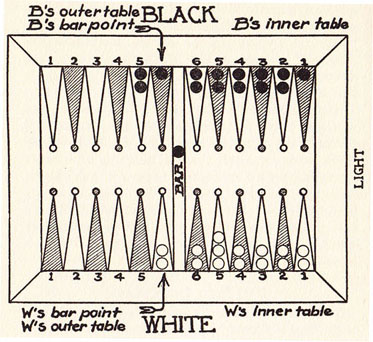
| Diagram 30 — Shut out |
| In the above diagram a perfect shut out is accomplished by White’s men. Every point on White’s inner table and White’s bar point is blocked against Black’s man which is on the bar. |

Chouette
By means of the second modern addition, Chouette, to the old game, Backgammon need no longer be limited to two players, but may be played by three, four, five or any reasonable number.
Chouette can be described as playing alone against two or more adversaries.
When played by three players, each player commences by throwing one die. The one who throws the highest number is said to be “in the box” and plays against the one who has thrown the second highest number. The third player, who has thrown the lowest number, is temporarily inactive. However, the third player, although inactive, is a partner of the second player, having the same interest against the common adversary in the box. If the player in the box loses the game, he loses the amount of the stake to each of the others. In like manner, if he wins, he wins double, that is, the amount of the stake from each of the other two players.
If the player in the box wins the game, his opponent, the second player, withdraws and sits to one side, while the third player takes his place and plays the next game against the player in the box with the former second player as his partner.
The game proceeds in this way, the players not in the box playing alternately against the player in the box until one of them defeats him. When this is done, the one who has succeeded in defeating the player in the box, becomes the player in the box and continues in the same manner to play alternately against the other two, now partners, until he loses to one of them. The defeated player in the box takes his place at the foot of the list of the inactive players of the opposition.
During the play, while the active partner plays the game and must decide all questions of play and of doubling, the inactive partner may freely advise and make suggestions.
For more than three players, Chouette is played in the same manner, the additional players being additional inactive partners of the second player. These additional players may be consulted, make suggestions, have the same interest in the game and in their turn play against the common adversary in the box, until one of them defeats him and takes his place.

Tables Of Chance
In Backgammon the law of average plays an important part. With the two dice there are thirty-six possible throws. With the exception of doublets any combination can be thrown two ways. Example, the first die may be a six and the second die a two, making a combination of eight. Reversed the first die may be a two and the second die a six. The following table shows the thirty-six possible throws with two dice:

The above table shows that there is only one chance in thirty-six for any particular doublet. Therefore the chances against throwing any given doublet are thirty-five to one.
Because any combination, exclusive of doublets, can be thrown in two ways, there are two chances in thirty-four or one in seventeen of throwing any particular combination.
The average throw with two dice is estimated to be eight.
We must consider the thirty-six possible throws in order to arrive at the chances of throwing any given number with two dice. For instance: In how many of the thirty-six throws can a given number appear? Take six for example — six (or a combination from which a six can be taken) can appear in only seventeen of the thirty-six throws. This leaves nineteen throws in which it does not appear. This means that the chances of throwing a six or a combination that makes six are seventeen to nineteen.
The chances of a “blot” being taken up when it is exposed to any of the possible throws with two dice are shown in the following table:
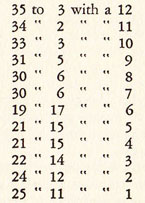
From the above table it is seen that theoretically though not always in practice a “blot” within reach of a single die should be as close to the adversary’s nearest man as possible. If the results of the two dice are necessary to reach it the “blot” should be as far away as possible from the adversary’s nearest man.
The above is a table of chances. It is not wise to place too much confidence in following it as in practice the dice frequently surprise us by doing the unexpected.

Authorized Rules For Modern Backgammon For 1931
- The game may be played with (a) two dice boxes and two pairs of dice; or (b) two dice boxes and one pair of dice; or (c) one dice box and one pair of dice. In case of disagreement, the player throwing the higher die shall have the choice.
- The game shall be set up so that the inner tables are nearest the light. Decision as to position of light and choice of dice, men and seats shall be made by the player winning the throw for the first move.
- For the first move each player throws a single die. He who throws the higher number wins, and, for his first move, plays the pips upon both his own and his opponent’s die. After that each player throws and plays two dice.
- Each tie, when throwing for first move, automatically doubles the stake. This is optional. Automatic doubles may be limited in number or not played.
- Both dice must be taken up and thrown again:
- If the player has not thrown the dice into the tables on his right hand.
- If either die is upon, or “cocked” against, the other die, a man, or a side or end of the tables.
- If either die jumps into the other tables or off the board.
- If either player touches either die during the throw or before it has come to rest.
- If a player throws his dice before his adversary’s play is completed.
- The player must leave his dice upon the board until his play is completed. Should he pick them up before the completion of his play, the opponent may, at his option, declare the play void and require the offender to replace the man or men moved and to throw again.
- A play is completed when the move or moves required by the dice have been made and the man or men quitted. After a play has been so completed (correctly), it cannot be changed.
- If a man has been moved the wrong number of points, or entered incorrectly, or thrown off before all are home, the opponent may, at his option, and before he has thrown, demand that the error be corrected. After the opponent has thrown, errors of play cannot be corrected except by mutual consent.
- The numbers on both dice must be played if possible. Either may be played first. If either, but only one, of the numbers thrown can be played, the higher must be played.
- Whenever a man has been moved from its position upon a point it must be played if possible.
- Either player may offer the first double of the original stake. After that the right to double the stake alternates, being always with the player who has accepted the last double.
In every case, a double may be offered only when it is the player’s turn to play and before he has thrown the dice. A double may be accepted or declined. The refusal of a double terminates the game and the player refusing them loses whatever his stake may amount to at that time.
-
- A single game is won by the player who first bears or throws off all of his men.
- A Gammon, or double game, is won if the adversary has not thrown off a single man. This doubles the amount of the stake whatever it may be.
- A Backgammon, or triple game, is won if the adversary has not thrown off a single man and has one or more men in the winner’s inner table or upon the bar. This triples the stake. It is optional whether or not triple games be played.